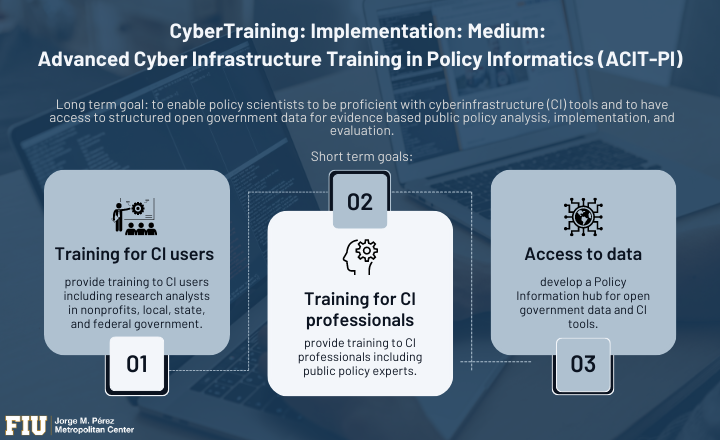- Home
- Cyberinfrastructure
Cyberinfrastructure
Introduction
Welcome to this web page of the National Science Foundation supported project (Award # 1924154), CyberTraining: Implementation: Medium: Advanced Cyber Infrastructure Training in Policy Informatics (ACIT-PI). The project is funded through the NSF's Office of Advanced Cyberinfrastructure (OAC), Directorate for Computer and Information Science and Engineering (CISE).
What is Cyberinfrastructure?
Quite simply, cyberinfrastructure is the infrastructure required to run the current knowledge economy. It can be thought of much in the same way as the physical infrastructure to provide electricity, water, telephones and roads, which have formed the basis for modern societies' economic and trade networks. Cyberinfrastructure, even in its embryonic form, promises to be as revolutionary as the coming of water and electric power was for our cities. It can be viewed as a tightly integrated, planet-wide grid of computing, information, networking and sensor resources—a grid that we could tap into like water or power (i.e. plug and play).
Technically, cyberinfrastructure refers to infrastructure based upon distributed computer, information and communication technology. The base technologies underlying cyberinfrastructure are the integrated hardware components of computation, storage, and communication. Above the cyberinfrastructure layer are software programs, services, instruments, data, information, knowledge, and social practices applicable to each discipline. Cyberinfrastructure is between these two layers, comprising the enabling hardware, algorithms, software, communications, institutions, and personnel.
With a well-established cyberinfrastructure, public policy, administration and other allied disciplines' researchers will have the power of the world's highest-performance digital resources at their disposal. With the computational power, new algorithms based on artificial intelligence techniques, and the massive administrative data, we can attempt to answer questions that had previously been unapproachable because the requirements were too much, too hard, too long or too complex.
For upcoming events, click here.





